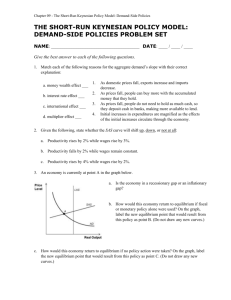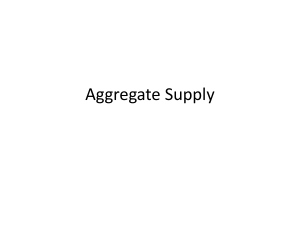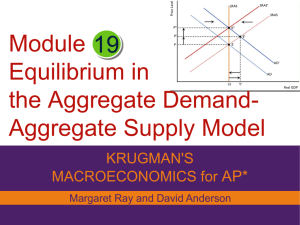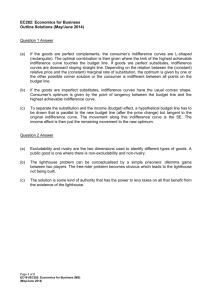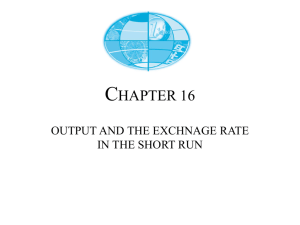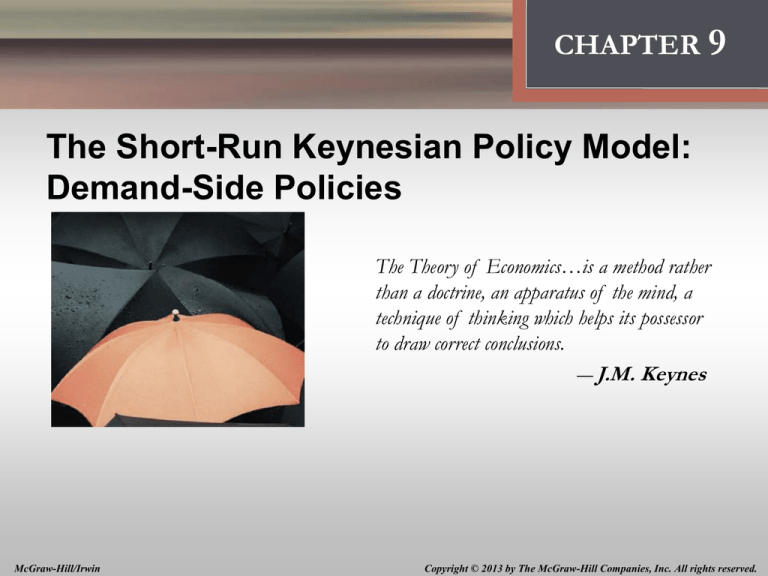
Introduction:
Thinking Like an Economist
CHAPTER 9
The Short-Run Keynesian Policy Model:
Demand-Side Policies
The Theory of Economics…is a method rather
than a doctrine, an apparatus of the mind, a
technique of thinking which helps its possessor
to draw correct conclusions.
― J.M. Keynes
McGraw-Hill/Irwin
Copyright © 2013 by The McGraw-Hill Companies, Inc. All rights reserved.
The Short-Run Keynesian Policy
Model: Demand-Side Policies
19
Key Insight of the Keynesian AS/AD Model
Short-run equilibrium output may differ from long-run
potential output assuming a fixed price level
• Equilibrium output is the level of output toward
which the economy gravitates in the short run
because of the cumulative cycles of declining or
increasing production
• Potential output is the highest amount of output an
economy can sustainably produce using existing
production processes and resources
Market forces may not be strong enough to correct
deviations from potential output
9-2
The Short-Run Keynesian Policy
Model: Demand-Side Policies
19
Key Insight of the Keynesian AS/AD Model
Paradox of thrift
• In the long run, saving leads to investment and growth
• In the short run, saving may lead to a decrease in
spending, output, and employment
Aggregate demand management, which is government’s
attempt to control the aggregate level of spending, may be
necessary
Keynesian economists advocated an activist demand
management policy
9-3
The Short-Run Keynesian Policy
Model: Demand-Side Policies
19
US Savings Rates
9-4
The Short-Run Keynesian Policy
Model: Demand-Side Policies
19
The Components of the AS/AD Model
Aggregate Demand Curve (AD)
• Is a curve that shows how a change in the price level
will change aggregate expenditures on all goods and
services in an economy
Short-Run Aggregate Supply Curve (SAS)
• Is a curve that specifies how a shift in the aggregate
demand curve affects the price level and real output in
the short run, other things constant
Long-Run Aggregate Supply Curve (LAS)
• Is a curve that shows the long-run relationship between
output and the price level
9-5
The Short-Run Keynesian Policy
Model: Demand-Side Policies
19
The Slope of the AD Curve
The AD curve is downward sloping because of:
Interest rate effect, the effect that a lower price level
has on investment expenditures through the effect that
a change in the price level has on interest rates
International effect, as the price level falls (assuming
the exchange rate does not change), net exports will
rise
Money wealth effect, a fall in the price level will make
the holders of money richer, so they buy more
Multiplier effect, the amplification of initial changes in
expenditures
9-6
The Short-Run Keynesian Policy
Model: Demand-Side Policies
19
The Slope of the AD Curve
Price level
The AD curve is downward
sloping because of the
interest rate, international,
and money wealth effects
P0
and the multiplier effect
P1
AD
Y0 Y1
Y2
Real
output
9-7
The Short-Run Keynesian Policy
Model: Demand-Side Policies
19
Dynamic Price Level Adjustment Feedback Effects
Dynamic effects exist that can counteract the
standard AD shift factors; If strong enough, can
cause AD to fall (shift to the left) when the price
level falls
Especially important when aggregate demand is
declining
• Expectations of falling aggregate demand
• Lower asset prices (declining nominal wealth)
• Financial panics
9-8
The Short-Run Keynesian Policy
Model: Demand-Side Policies
19
Shifts in the AD Curve
A shift in the AD curve means that at every price level, total
expenditures have changed. Five important shift factors are:
• Foreign income
• Exchange rates
• Distribution of income
• Expectations
• Monetary and fiscal policy
Deliberate shifting of the AD curve is what most policy
makers mean by macro policy, or AD management
9-9
The Short-Run Keynesian Policy
Model: Demand-Side Policies
19
Shifts in the AD Curve
The AD curve shifts out by
more than the initial change
in expenditures
Price level
• Exports increase by 100
Initial Multiplier
effect
effect
• The multiplier magnifies
this shift (assuming
multiplier = 3)
P0
Total effect
100
200
AD0
300
AD1
AD curve shifts to the
right by a multiple of 100,
in this case by 300
Real
output
9-10
The Short-Run Keynesian Policy
Model: Demand-Side Policies
19
The Aggregate Supply Curves
The Slope of the Short-Run Aggregate Supply (SAS) Curve
The SAS curve is upward sloping because of:
Auction markets
• Prices are determined by demand and supply and
supply curves are upward sloping (higher P, higher Q)
Posted price markets
• Also called quantity-adjusting markets, markets in
which firms respond to changes in demand by
changing production instead of changing their prices
• Firms tend to increase their markup when demand
increases
9-11
The Short-Run Keynesian Policy
Model: Demand-Side Policies
19
Shifts in the SAS Curve
Price level
SAS1
SAS0
SAS2
Shifts in the SAS are caused by
changes in:
• Input prices
• Productivity
• Import prices
• Excise and sales taxes
When production costs increase,
the SAS curve shifts up
In general:
Real output
%Δ in price level =
%Δ in wages – %Δ in productivity
9-12
The Short-Run Keynesian Policy
Model: Demand-Side Policies
19
The Long-Run Aggregate Supply Curve
The long-run aggregate supply (LAS) curve shows the
long-run relationship between output and the price level
The position of the LAS curve depends on potential
output which is the amount of goods and services an
economy can produce when both capital and labor are
fully employed
The LAS curve is vertical because potential output is
unaffected by the price level
9-13
The Short-Run Keynesian Policy
Model: Demand-Side Policies
19
The LAS Curve
Price level
LAS
Potential output is assumed to be in
the middle of a range bounded by high
and low levels of potential output
C
SAS
B
A
Overutilized
resources
Underutilized
resources
Low-level
potential
output
High-level
potential
output
Real
output
• When resources are overutilized (point C), factor prices
may be bid up and the SAS
shifts up
• When resources are underutilized (point A), factor
prices may decrease and
SAS shifts down
9-14
The Short-Run Keynesian Policy
Model: Demand-Side Policies
19
Shifts in the LAS Curve
Price level
LAS0
LAS1
LAS2
Increases in the LAS are
caused by increases in:
Capital
Resources
Growth-compatible
institutions
Technology
Entrepreneurship
Real output
9-15
The Short-Run Keynesian Policy
Model: Demand-Side Policies
19
Short-Run Equilibrium in the AD/AS Model
Price level
Short-run equilibrium is where the
SAS and AD curves intersect and
point E is short-run equilibrium
F
P1
P0
SAS
E
AD1
A shift in the aggregate
demand curve to the right
changes equilibrium from E
to F, increasing output from
Y0 to Y1 and increasing
price level from P0 to P1
AD0
Y0
Y1
Real output
9-16
The Short-Run Keynesian Policy
Model: Demand-Side Policies
19
Short-Run Equilibrium in the AD/AS Model
Price level
SAS1
P2
P0
SAS0
G
E
A shift up in the short-run
aggregate supply curve
changes equilibrium from E
to G, decreasing output from
Y0 to Y2 and increasing price
level from P0 to P2
AD
Y2 Y0
Real output
9-17
The Short-Run Keynesian Policy
Model: Demand-Side Policies
19
Long-Run Equilibrium in the AD/AS Model
Price level
P1
P0
Long-run equilibrium is where the
LAS and AD curves intersect
LAS
A shift in the aggregate
demand curve changes
equilibrium from E to H,
increasing the price level
from P0 to P1 but leaving
output unchanged
H
E
AD1
AD0
YP
Real output
9-18
The Short-Run Keynesian Policy
Model: Demand-Side Policies
19
Application:
A Recessionary Gap in the AD/AS Model
Price level
LAS
SAS1
A
SAS0
P1
E
P0
Gap
Y1
YP
AD0
• A recessionary gap is the
amount by which equilibrium
output is below potential output
• At point A, some resources
are unemployed and the
recessionary gap is YP – Y1
Eventually wages and prices
decrease and SAS shifts
down to return the economy
to a long and short-run
equilibrium at E
Real output
9-19
The Short-Run Keynesian Policy
Model: Demand-Side Policies
19
Application:
An Inflationary Gap in the AD/AS Model
Price level
• An inflationary gap is the
amount by which equilibrium
output is above potential output
LAS
SAS0
P0
E
SAS2
B
P2
Gap
YP
• At point B, resources are being
used beyond their potential and
the inflationary gap is Y2 – YP
Y2
AD0
Eventually wages and prices
increase and SAS shifts to
return the economy to a long
and short-run equilibrium at E
Real output
9-20
The Short-Run Keynesian Policy
Model: Demand-Side Policies
19
Utilizing the AS/AD Model:
Aggregate Demand Policy
A primary reason for government policy makers’ interest
in the AS/AD model is that monetary or fiscal policy
shifts the AD curve
• Monetary policy involves the Federal Reserve
Bank changing the money supply and interest
rates
• Fiscal policy is the deliberate change in either
government spending or taxes to stimulate or
slow down the economy
9-21
The Short-Run Keynesian Policy
Model: Demand-Side Policies
19
Utilizing the AS/AD Model:
Aggregate Demand Policy
Countercyclical fiscal policy is fiscal policy in
which the government offsets any change in
aggregate expenditures that would create a
business cycle
Fine-tuning is used to describe such fiscal policy
designed to keep the economy always at its target
or potential level of income
9-22
The Short-Run Keynesian Policy
Model: Demand-Side Policies
19
Application:
Expansionary Fiscal Policy in the AD/AS
Model
Price level
• If the economy is at point A,
there is a recessionary gap
equal to YP – Y0
LAS
P1
• The appropriate fiscal policy
is to increase government
spending and/or decrease taxes
E
P0
A
Gap
Y0
AD0
YP
AD1
AD shifts to the right and
output returns to potential
output YP and prices
increase to P1
Real output
9-23
The Short-Run Keynesian Policy
Model: Demand-Side Policies
19
Application:
Contractionary Fiscal Policy in the AD/AS
Model
Price level
LAS
• If the economy is point B, there
is an inflationary gap Y2 – YP
B
P2
P1
• The appropriate fiscal policy
is to decrease government
spending and/or increase taxes
E
AD0
Gap
YP
Y2
AD shifts to the left, output
returns to potential output YP
and inflation is prevented
AD2
Real output
9-24
The Short-Run Keynesian Policy
Model: Demand-Side Policies
19
Limitations of the AS/AD Model
Feedback effects mentioned earlier
Potential output is difficult to estimate precisely
The economy can become dynamically unstable—a shock
can generate changes that are not self-correcting
Implementing fiscal policy through changing taxes and
government spending can be a slow legislative process
• There is no guarantee that government will do what
economists say is necessary
• Automatic stabilizers can avoid this (automatic tax
and spending policies that are programmed to occur
without additional government action)
9-25
The Short-Run Keynesian Policy
Model: Demand-Side Policies
19
Chapter Summary
The key idea of the Keynesian AS/AD model is that in the
short run the economy can deviate from potential output
The AS/AD model consists of the aggregate demand
curve, and the short-run aggregate supply curve, and the
long-run aggregate supply curve
Short-run equilibrium is where the SAS and AD curves
intersect; Long-run equilibrium is where the AD and LAS
curves intersect
Aggregate demand management policy attempts to
influence the level of output in the economy
9-26

